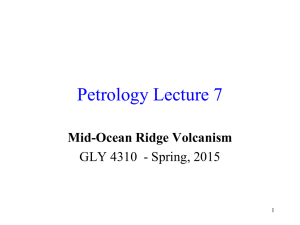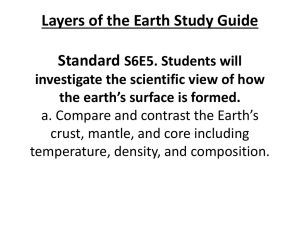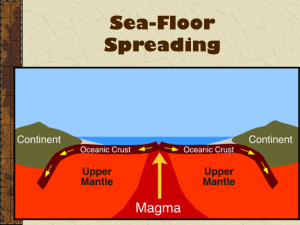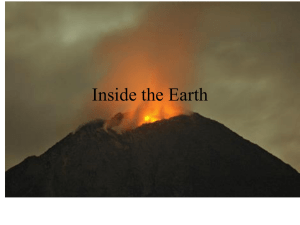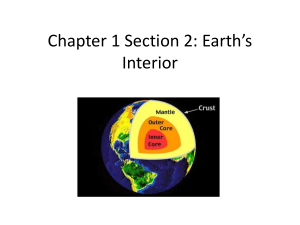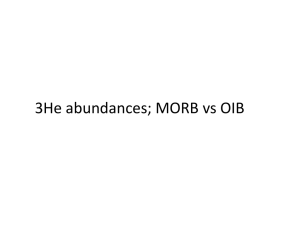ppt
advertisement
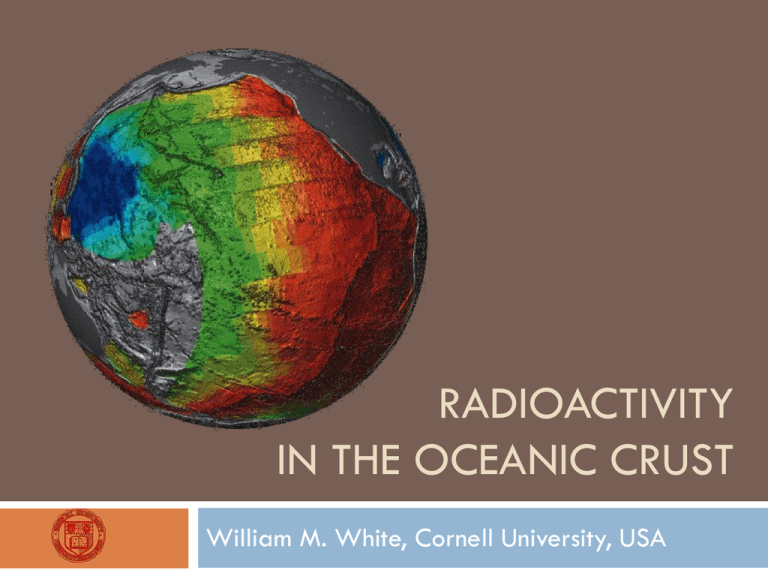
RADIOACTIVITY IN THE OCEANIC CRUST William M. White, Cornell University, USA Creation of Oceanic Crust Oceanic crust is produced as magmas rise from the mantle below and ‘freeze’ to fill the gap as lithospheric plates spread apart. Some of this magma erupts on the seafloor as lava flows. Some freezes in the conduits to the surface (the sheeted dike complex). Most crystallizes within the crust to form the gabbroic layer. MORB Lava flows at mid-ocean ridges are readily sampled (by dredging, among other things; the rest of the crust is less easily sampled). The lavas that erupt along mid-ocean ridges are basalts with a distinct, and uniform composition (at least by comparison to other environments). They are given the name “Mid-Ocean Ridge Basalts” or MORB. Spider Diagrams & Incompatible Elements Spider Diagrams & Incompatible Elements MORB are depleted in incompatible elements Th Distribution in MORB Mean Concentrations of Th, U, and K in MORB Th ppm 0.404 K ppm 1328 Th/U K/U Mean U ppm 0.119 3.1 14836 2σmean 0.026 .077 71 0.029 227 n 2205 2367 2466 2167 1743 Back-Arc Basins U ppm Th ppm K ppm Th/U K/U (MORB) (0.119) (0.404) (1328) 3.1 14836 Mean 0.137 0.399 2258 2.69 20013 2 σmean 0.049 .013 200 0.06 815 361 362 332 361 242 n Grand Average: MORB + BABB Gale et al. (2012) Mean 2σmean n U ppm Th ppm K ppm 0.123 0.013 2759 0.407 .072 2566 1369 125 2798 MORB vs. the Oceanic Crust Radioactivity in MORB is easy to estimate, but MORB represents only the volcanic layer – ~15% of less of the crust. Because of igneous differentiation, we expect the gabbroic layer to have different Th, U, and K contents. Fractional Crystallization Because minerals crystallizing from basaltic magma have compositions different from the magma, the composition of the magma evolves. Because most of these minerals exclude K, U, and Th, their concentration increases. The question is not what composition comes out the top of a mid-ocean ridge volcano, but what goes in the the bottom from the mantle. We can’t analyze it, we have to model it. Magma Evolution Model MORB magma is derived from an olivine-dominated mantle, whose composition (Mg/(Mg+Fe) we think we know (~0.9). We assume magma entering the crust has this composition. We use a thermodynamic model of magma evolution to calculate the amount of fractional crystallization that must have occurred, then calculate K, Th, and U in the “parent” magma. Calculated Parental Magma ‘MELTS’ model indicates that average erupted MORB has experienced ~39% crystallization, with removal of 5% olivine, 18% plagioclase, 16% clinopyroxene, and <1% spinel-magnetite. U ppm Th ppm K ppm MORB 0.123 0.407 1369 Bulk Ocean Crust 0.08 0.26 720 ~0.006 ~0.021 ~60 Implied Source Oceanic Plateaus From Kerr TOG (2013) Oceanic Plateaus U ppm Th ppm K ppm 0.123 0.407 1369 Plateau Basalts 0.4 1.3 3039 Bulk ‘Normal’ Crust 0.08 0.26 720 Bulk ‘Plateau’ Crust 0.25 0.82 1600 MORB Basalt-Seawater Interaction Hydrothermal reactions between oceanic crust and seawater affect U and K concentrations of the oceanic crust. Staudigel (2013) estimates 402 mg/kg K uptake 0.0307 mg/kg U uptake U, Th, and K in ‘mature’ oceanic crust U ppm Th ppm K ppm Bulk ‘Normal’ Mature Crust 0.08 0.26 1120 Bulk ‘Plateau’ Mature Crust 0.29 0.82 2000 Continental Crust 1.31 5.61 15200 Volumes & Masses ‘Normal’ Crust Area km2 Thicknes s km Volume km3 Density kg/m3 Mass kg 2.8 x 108 7 2.06 x 109 2800* 5.95 x 1021 3.79 x 106* 2800* 1.1 x 1019 Plateaus *Schubert & Sandwell (1980) Total Radioactivity in Oceanic Crust U kg Th kg K kg Mature Normal 6.55 x 1014 1.55 x 1015 6.67 x 1018 Mature Plateaus 3.19x1012 — 2.2 x1016 Total Mature 6.58 x 1014 1.56 x 1015 6.69 x 1018 ν yr-1 2.57 x 106 1.33 x 106 1.33 x 107 Heat Production in the Oceanic Crust Specific heat production Mass (fresh) Heat, TW U µW/kg Th µW/kg K µW/kg 98.14 26.36 3.45 x 10-3 6.59 x 1014 4.79 x 1014 0.065 0.047 1.56 x 1015 0.041 0.041 6.69 x 1018 4.30 x 1018 0.021 0.015 Total Estimated Mature (Fresh) Oceanic Crust Heat Production: 0.129 (0.103) TW (0.6 to 0.8% of total terrestrial)
